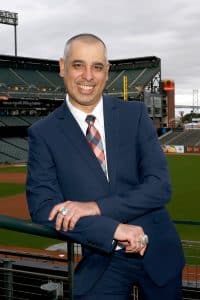
In business, it is often thought that multitasking maximizes efficiency. But it can actually have the opposite effect, according to Luis Lozada, director of purchasing for the San Francisco Giants. A centralized purchasing department like his, which focuses exclusively on buying the best products for the best price, has proven to greatly enhance the team’s bottom line.
“When you centralize a purchasing department with one role dedicated to looking for vendors, you naturally get better pricing compared to having purchasing be an additional duty for someone in marketing or human resources,” Lozada asserts. “People tend to focus first on their core responsibilities and may wait too long to place an order and have to pay more, or rely on just a few vendors rather than build a diverse list that can offer more options.”
Dealing with vendors may not be a favorite task for folks in marketing or human resources, but for Lozada, building relationships with the vendors is the key job component that he finds most rewarding. Vendors also appreciate the chance to work with one person whose needs they can grow to anticipate. Lozada also enjoys coordinating requests from several departments to maximize volume.
He is able to save the team millions of dollars through a well-planned approach, suggestive of someone with his
unique background.
Lozada didn’t always work in purchasing; he began his career as mechanical engineer. He moved with his wife, Tatiana, and two daughters from Valencia, Venezuela, to the United States in 1999 to pursue a master’s degree in management technology from the University of Wisconsin. “I went from designing cryogenic tanks to purchasing bobble heads,” he jokes.
While working for Polaroid, he moved to the supply chain side of the business, which houses purchasing. In 2009, the Minnesota Twins approached him to help them transition from a paper process for issuing and executing purchase orders to an automated system.
Three years later, the Giants recruited him to do the same thing for them. Lozada estimates that he has saved the San Francisco team $2.1 million since coming on board.
“We had a new vice president of human resources, Leilani Gayles, who recommended the change,” he explains. “Also, our former CFO, John Yee, attended a presentation by the [Seattle] Mariners on why they converted to centralized purchasing. He was impressed with the control and discipline it required and the benefits it would bring.”
While this business model would seem to make perfect sense, fewer than half of the thirty teams in Major League Baseball (MLB) have made the switch to a centralized purchasing department, Lozada says.
One reason for resisting may be the assumption that focusing on lowering costs will result in lowered quality. The need to purchase in greater volumes also necessitates using vendors who are connected to factories overseas in order to keep costs low. With this in mind, Lozada says that quality becomes a greater priority—the last thing the team wants is a product than can injure a fan.
Quality is such a factor that the first priority for any purchasing director is to establish trust. “Department heads may be anxious about giving up control so you need to assure them that they are still in charge,” Lozada advises. “I tell them this is a collaborative effort. You get to approve what I order; I’m just going to help you stay in budget.”
“I tell them this is a collaborative effort. You get to approve what I order; I’m just going to help you stay in budget.”
The Giants were listening. The team just implemented a new program that approves everything they need before the purchasing is done.
There is still resistance by some teams because the trend is still fairly new. Purchasing departments for MLB teams began appearing between fifteen and twenty years ago, according to Lozada, beginning with the Chicago White Sox and Seattle Mariners.
In 2012, MLB Commissioner Bud Selig issued a challenge to all the teams to increase supplier diversity by including more women and minority-owned business enterprises (WBEs and MBEs). Every team is required to present a demographic breakdown of its vendors annually. The teams are ranked, from most to least diverse, based on these figures. No one wants to be at the bottom, asserts Lozada, which may motivate more teams to make the switch. The Giants ranked third last year.
While he embraces the challenge, Lozada admits that it has also increased his workload. “Smaller businesses need more guidance through the bidding process, especially if they’ve never worked with a baseball team, but you have to make an effort.”
His experience with the Twins and Giants also taught him that working with smaller, local businesses has its advantages, even over larger MBEs or WBEs, because of the emotional investment in the team. “They could be season ticket holders and that gives them an added incentive to excel as a vendor,” he says.
For Lozada, being able to provide major opportunities to smaller, minority-owned businesses is a great perk of the job.

